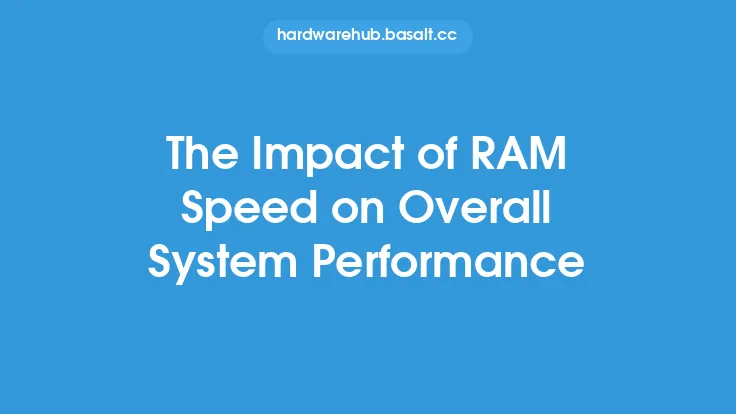The central processing unit (CPU) is the brain of a computer system, responsible for executing instructions and handling data. The architecture of a CPU plays a crucial role in determining the overall performance of a system. CPU architecture refers to the design and organization of the components within a CPU, including the execution units, memory hierarchy, and interconnects. In this article, we will delve into the impact of CPU architecture on system performance, exploring the key factors that influence processing speed, efficiency, and overall system behavior.
Introduction to CPU Architecture
CPU architecture is a complex and multifaceted field, encompassing various aspects of processor design. The architecture of a CPU determines how instructions are executed, how data is accessed and processed, and how the processor interacts with other system components. A well-designed CPU architecture can significantly enhance system performance, while a poorly designed architecture can lead to bottlenecks and inefficiencies. The key components of CPU architecture include the instruction set architecture (ISA), execution units, memory hierarchy, and interconnects. Understanding how these components interact and influence system performance is essential for optimizing CPU design and achieving optimal performance.
Execution Units and Instruction-Level Parallelism
Execution units are the components of a CPU responsible for executing instructions. These units can include arithmetic logic units (ALUs), floating-point units (FPUs), and load/store units. The number and type of execution units can significantly impact system performance, as they determine the number of instructions that can be executed concurrently. Instruction-level parallelism (ILP) is a technique used to improve performance by executing multiple instructions simultaneously. ILP can be achieved through various methods, including pipelining, superscalar execution, and simultaneous multithreading (SMT). The design of execution units and the implementation of ILP techniques can significantly influence system performance, making them critical components of CPU architecture.
Memory Hierarchy and Data Access
The memory hierarchy is a critical component of CPU architecture, responsible for storing and retrieving data. The memory hierarchy typically consists of multiple levels, including registers, cache memory, and main memory. The design of the memory hierarchy can significantly impact system performance, as it determines the speed and efficiency of data access. A well-designed memory hierarchy can minimize memory access latency, reducing the time it takes for the CPU to access and process data. The use of cache memory, in particular, can significantly improve performance by reducing the number of memory accesses and minimizing latency. The design of the memory hierarchy must balance the trade-offs between access speed, capacity, and power consumption, making it a challenging and critical aspect of CPU architecture.
Interconnects and Communication
Interconnects are the communication pathways between components within a CPU and between the CPU and other system components. The design of interconnects can significantly impact system performance, as they determine the speed and efficiency of data transfer. Interconnects can include buses, networks, and point-to-point links, each with its own advantages and disadvantages. The choice of interconnect technology and topology can influence system performance, power consumption, and scalability. In modern CPU architectures, interconnects play a critical role in enabling high-performance computing, as they facilitate the transfer of large amounts of data between components.
Power Consumption and Thermal Management
Power consumption and thermal management are critical aspects of CPU architecture, as they determine the energy efficiency and reliability of a system. The power consumption of a CPU is influenced by various factors, including the number and type of execution units, memory hierarchy, and interconnects. The design of a CPU must balance performance and power consumption, as excessive power consumption can lead to thermal issues and reduced system reliability. Thermal management techniques, such as cooling systems and thermal interfaces, are used to mitigate the effects of high power consumption and ensure reliable system operation. The development of power-efficient CPU architectures is essential for enabling mobile and embedded systems, where power consumption is a critical constraint.
Scalability and Multicore Architectures
Scalability is a critical aspect of CPU architecture, as it determines the ability of a system to handle increasing workloads and performance demands. Multicore architectures, which integrate multiple processing cores on a single chip, have become a dominant trend in CPU design. Multicore architectures offer improved performance, power efficiency, and scalability, making them suitable for a wide range of applications. The design of multicore architectures must balance the trade-offs between core count, clock speed, and power consumption, making it a challenging and complex aspect of CPU architecture. The use of multicore architectures has enabled the development of high-performance computing systems, including servers, data centers, and supercomputers.
Conclusion
In conclusion, the architecture of a CPU has a profound impact on system performance, influencing processing speed, efficiency, and overall system behavior. The design of execution units, memory hierarchy, interconnects, and power management systems must be carefully balanced to achieve optimal performance. The development of power-efficient, scalable, and high-performance CPU architectures is essential for enabling a wide range of applications, from mobile and embedded systems to high-performance computing and data centers. As CPU architecture continues to evolve, it is essential to understand the complex interactions between components and the trade-offs involved in designing high-performance systems. By exploring the impact of CPU architecture on system performance, we can gain a deeper appreciation for the complex and fascinating world of CPU design and development.





